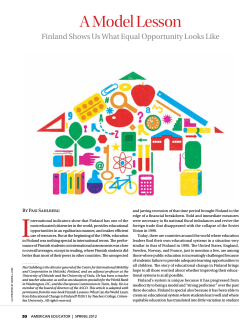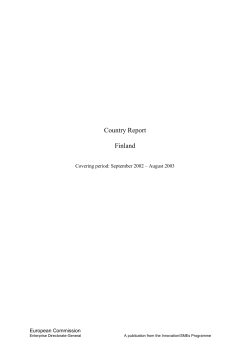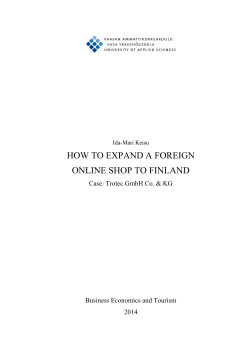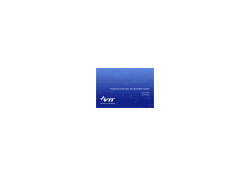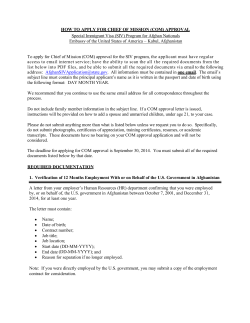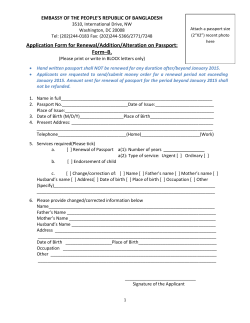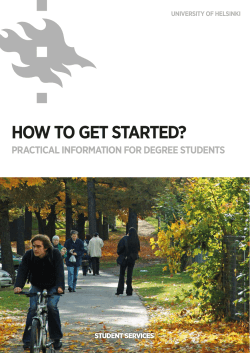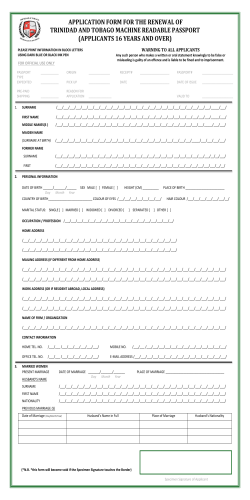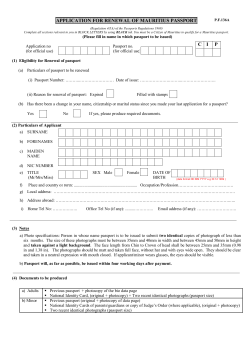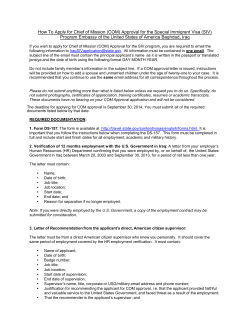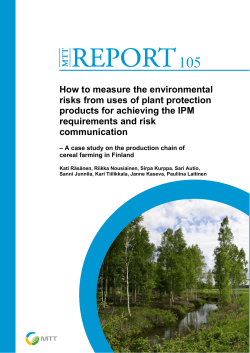
How to trace your roots in Finland Elisabeth Uschanov | Krister Björklund Siirtolaisuusinstituutti
How to trace your roots in Finland Elisabeth Uschanov | Krister Björklund Siirtolaisuusinstituutti Migrationsinstitutet Institute of Migration The Institute of Migration The Institute of Migration was founded in 1974, and has its headquarters in Turku. The Institute is maintained by a non-profit-making trust and is basically financed by an annual operating grant from the Finnish Ministry of Education. The Institute carries out and promotes research in the field of migration, historical as well as contemporary and also collects and stores different kinds of material relating to migration and ethnic questions. The Institute maintains a register of researchers working in these fields, arranges seminars and conferences to promote scholarly collaboration. The Institute is responsible for six series of scholarly publications and publishes its own quarterly periodical Siirtolaisuus-Migration. The Archives of the Institute contain approx. 220 meters of documents, ca. 14 000 photographs, letters, post cards, interviews, musical recordings, museum pieces etc. The Institute Library specializes in scholarly and other publications relating to international and domestic migration. The Library subscribes to most of Finnish newspapers and magazines published in other countries around the world and to many specialist periodicals dealing with migration. The library counts more than 7 000 titles, and information service is available for the public. One important way in which the Institute promotes a greater awareness of migration is through arranging exhibitions. The Emigrant Register was established in 1989 as a service for genealogists and the descendants of Finnish emigrants. The foundation of a computerized register was a part of the Delaware 350 Anniversary, to commemorate the beginning of Finnish Emigration to North America. The data is mostly related to the migration event, the databases of the main sources of information, official passport registers and passenger lists of the Finland Steamship Company are available on the Internet. The web site of the Institute at http://www.migrationinstitute.fi / provides articles, reports, the institute’s periodical, statistics, picture galleries, exhibitions, a web shop where you can buy books, useful links and other information concerning Finnish migration. Institute of Migration Eerikinkatu 34, 20100 Turku, Finland Tel. +358 2 2840 440 www.migrationinstitute.fi 2 Contents The Institute of Migration Introduction Overview of Finnish Migration to America Start Your Search in North American Records Family Papers Official Records in North America Vital Records Census The SSDI Church Records Other Documents Documents Related to the Journey Lists of Arrivals St. Albans Border Crossings Lists of Departures The Passenger Lists of the Finland Steamship Company (F.Å.A) The Passport Lists Finnish Names Emigrants Changing their Names Records in Finland Church Records The Genealogy Method and available Church Records Other Archival Sources Literature Research Guide Books Finnish History and Migration Addresses 3 2 4 5 5 5 6 7 7 8 8 8 8 10 11 11 11 12 13 14 15 15 16 18 20 20 20 22 Introduction The popularity of tracing one’s roots seems to be constantly increasing. Many genealogists feel at some point in their research that they have reached a point where no more information can be dug into daylight and those who are tracing their overseas roots are more likely than other to run into what seems to be a brick wall. To carry on the search for their relatives, the information needed is to identify the place where the ancestors lived. Those who have Nordic ancestry are better off than others, as the parishes have kept good records, which reach hundreds of years back, but the genealogist still needs to know where to search. Many start with great enthusiasm and high hopes, but the abundance of information on the internet easily leads astray and guidance is needed through the jungle of information. For those who plan to visit Finland to find their roots, good preparation is crucial, as much of the information can be gathered in advance and the better they prepare, the more they can find during their trip. The purpose of this booklet is to help Finnish descendants to trace their roots. In the following pages the most important information sources in Finland are described and what the genealogist can expect to find. Many of the sources can be utilized at home, through the Internet, by mail or telephone, but some of the basic information can only be researched on the spot. The reader should not expect a complete guide to genealogical sources in Finland, but these pages give an outline where to find the most important sources. 4 Overview of Finnish Migration to America The great migration of Finns to North America occurred during the late nineteenth and early twentieth century. Between the years 1864 and 1914 well over 300,000 Finns settled in the USA and Canada. The “America Fever” started in the 1870s and became a mass movement in the following decade. The crest of the wave was reached the year 1902 when over 20.000 Finns emigrated. Emigration continued on a large scale until the outbreak of World War I. When the U.S. Government began to restrict the admission of immigrants in the 1920s, Finnish emigration shifted to Canada. The Finnish emigration to the U.S. was higher than the official statistics of these years reveal, because many immigrants who officially were not admitted to the U.S. went first to Canada and then crossed the border between the countries. The Finnish emigrants to America originated mainly from north western Finland. Nearly half of them came from the province of Vaasa. They were young people, around 20 years of age; the majority was men and unmarried. The structural change in agriculture had created a population surplus, and jobs outside agriculture were scarce in Finland. In North America work was available for men in mines, lumber camps, factories and railroad construction. Women gained employment as maids in the homes of wealthy Americans. The Finnish settlements concentrated in Minnesota, Michigan and Massachusetts. Also in Oregon and New York the Finns were numerous. In Canada about 60 per cent of the Finnish population lived in Ontario, especially in Toronto, Sudbury and present Thunder Bay. Many Finns also settled on the West Coast, but relatively few in prairie territories or the French-speaking areas. Although the Finns formed less than one percent of the European immigration to North America their concentration, e.g. in Michigan and in Thunder Bay in Canada had a considerable impact on the local population. In mining in upper Michigan the Finns were quite visible, especially in the industrial strikes. A study made at Northern Michigan University drew the conclusion that the American Finns had influenced the English spoken in northern Michigan. Since the Second World war Finnish migration to North America has been quite insignificant; around 15 000 emigrants went to the United States and 27 000 to Canada. In North America there are about 45 000 first generation and 180 000 second generation Finns. Including later generations there are over a million people of Finnish extraction – a substantial contribution to the ethnic and cultural mosaic of the United States and Canada. Start Your Search in North American Records Family Papers Tracing your roots and genealogical research often means compiling bits and pieces of information together. Sometimes a paper of seemingly little interest or a remark by a relative can be an important push forward. Archives, offices and libraries often provide lots of ma- 5 terial for constructing the family tree, but before gathering and studying official documents for filling the blanks in your family history, you should start at home with the material in the possession of your family and relatives, oral information as well as written. The most important task is to determine the place in Finland where the family originally came from and what was the original Finnish name of the ancestors, which may have changed after arriving in America, intentionally or through marriage. If the ties and contacts to the old home country and the relatives there still remain, crossing the Atlantic is easy, but if there are no family ties left, finding the family on the other side of the Atlantic might require lots of work and effort. Parents, grandparents, great-grandparents and other elderly relatives remember details about persons and what happened in the past. Interviewing a relative can give lots of information, which cannot be found in any document. Notes about births, marriages and deaths in the old family bible provide valuable information when starting genealogical research. This information might, however, be incomplete and incorrect. Almost every family keeps birth-, marriage- and death certificates in their home archives, which are of great interest. Also old school-, military- and retirement records as well as membership records of associations and organizations give information on life of old. Often documents like deeds of estate distribution, land acquisition and the like can be found at home. It is also a common habit to collect obituaries and anniversary notices from newspapers about family members. All Finnish emigrants did not apply for American citizenship, but Certificates of Intention of becoming US citizens and Certificates of Naturalization are important documents when researching your family history. They do not necessarily list the place of origin in Finland, but always the arrival in America and often the name of the ship and port of arrival. The family member who once arrived in America might have brought along photographs and documents from the old country, which some relative could have in his possession. The most valuable document is the emigrant’s passport, because it shows the original name in Finland, date of birth, home parish, profession and the date of emigration. Sometimes the emigrant also had an extract from the parish register (virkatodistus, papinkirja, muuttotodistus) issued for the purpose of emigration. Old photographs are interesting, but unfortunately the names of the persons appearing are seldom written down. Notes and diaries written by the emigrant are very valuable as well as letters and postcards sent from Finland. These may contain addresses, names of persons and places, information on relatives and more. These documents are usually in Finnish or Swedish, which means that the genealogist needs assistance if he does not know the languages. Official Records in North America This section assists in doing genealogical research using official records in North America. It is most important to exhaust these before venturing into archival searches in Finland. Surprisingly much information as basis can be found quite close. 6 Vital Records In tracing the history of immigrants and their descendants, the public records of their new country are important sources of information. In North America, there is no national poll register; population records are the responsibility of State, County or City officials. Each state has the equivalent of a bureau of vital records. It’s generally called the “Bureau of Vital Statistics,” “Division of Records and Statistics,” “Division of Public Health,” “Vital Records Division,” or some similar title. Vital records document important events of an individual’s life: birth, marriage, death and divorce. In general, vital records weren’t kept in the United States until the early 1900s, only some local records in state archives and libraries go further back. The information in the documents varies. Usually they contain the full name of the individual involved in the event, the date of the event, and the county, state, or town where the event took place. Many vital records contain much more information than this. To request a copy of a vital record you normally need to contact the appropriate state agency. States require a fee for each certificate. In most cases, you pay first and then wait for the state agency to mail the record to you. Response time varies widely and can range from a week to several months. A comprehensive guide to vital records can be found at http://www.vitalrec.com. Much of this also applies for Canada, but as modern Canada is the merger of French and English colonies, each with its own language and record keeping methods, problems may arise. The privacy laws are also stricter than in the US. Generally, the Canadian provinces where most Finns went have local administrations not differing much from their American counterparts. Being part of the British Commonwealth, some Canadian records are kept in Great Britain, e.g. military archives from the First and Second World War. Census Censuses are good sources for genealogical information, since they also give information on household and family level. The United States Congress requisitioned the first official census in 1790 to ensure that each state was assigned a fair number of congressional representatives. One census is completed every ten years. The first time that Finns were listed separately in the US Census was in 1900. Earlier they were classified as Russian. The most recent records open to genealogists are those for the 1930 census. Information is given on e.g. name, marital status, number of children born (to the wife, widow or divorcee), year of immigration, whether naturalized or alien, whether able to speak English, occupation and much more data, depending on the year of the census. As in the United States, censuses were conducted in Canada every ten years. Returns from all of the censuses up to and including 1901 are freely available. The paper returns for censuses after 1901 (up to 1991) were destroyed after the records were put onto microfilm. These microfilms, under the control of Statistics Canada, are stored at the National Capital Region Federal Records Centre of the National Archives. Ancestry.com (http://ancestry.com) hosts online census records from 1790–1930 for both US and Canada. 7 The SSDI The Social Security Death Index (SSDI) is a good resource for finding information on Americans who died after the 1960s. Most of the information included in this index is from 1960’s to the present, although some data is from as early as 1937. A record will contain some or all of the following information: last name, first name, birth date, death date, Social Security number, the state of residence where the Social Security number (SSN) was issued, the last known residence and the location where the last benefit payment was sent. For individuals who died while residing outside of the U.S., the record may also include a special state or country residence code. SSDI is available at www.ancestry.com Church Records In addition to the public records, most churches also kept records of their members. In the Lutheran congregations set up by the Finnish immigrants, Finnish archive practices were observed: births, marriages and deaths were listed annually in chronological order. This information was then also recorded in the Congregation Records by family. Some 20 per cent of the Finnish emigrants were members. There were hundreds of Finnish and Swedish Finnish parishes in both the United States and Canada, but no complete list of these exists. The Genealogical Society of Finland gathers information of Finnish-American churches at http://www.genealogia.fi /church/index.htm Original records and microfilms of Finnish-American church records are kept at the Finnish-American Heritage Center at Finlandia University (former Suomi College) in Hancock, Michigan. The Center also has archival material on temperance and other societies, newspapers, periodicals, personal papers and more (http://www.finlandia.edu/heritage-centerin-finnish.html). Other Documents The officials dealing with immigrants produced a large amount of documentation. Researchers often overlook the importance of these as a source of family history information. Such are Naturalization records, land records (including “Plat Books”-map collections), probate records, taxation, military service, court records and inheritance records. They can be found from local officials and from the National Archives in USA and Canada. For genealogists the most important documents relating to the naturalization are the duplicate copies made after 1906, which are stored at the Immigration and Naturalization Service. Many of above mentioned records are available for a user fee at http:// www.ancestry.com Documents Related to the Journey Most of the Finns emigrated to North America over England. A small part of the Finnish emigration went through Germany. In the 1870’s and 1880’s it was also possible to travel directly to America through Norway, a possibility that many emigrants from North Finland used. Some Finnish emigrants chose to board an ocean liner in Copenhagen. In the 1920s a 8 great many Finns took the route from Gothenburg in Sweden directly to New York. The journey from Finland started in the 19th century at first with coastal vessels to Sweden, mainly to Stockholm, from where it was possible to take a ship directly to England or Germany. In 1874 the Wasa-Nordsjö Steampship, Inc. sailed a few times per summer from Vaasa to Hull, England. The most popular option, however, was to take the train from Stockholm to Gothenburg and continue with a ship to England. It was also possible to board a ship in Malmö. The travel route changed substantially at the end of the 1880s when the German shipbrokers Norddeutscher Loyd and HAPAG started trafficking from Hanko, the southernmost harbor in Finland, to Stockholm, Copenhagen and Lübeck and further to Hull in England. In the autumn of 1891 the Finnish Steamship Company started regular traffic between Hanko and Hull. The company also made an agreement with the Companies running the Ocean Liners from England to America. From the beginning of the 20th century most of the emigrants from Finland traveled with the Finnish Steamship company. During World War 1914– 1920 no ships went from Hanko and the emigrants had to leave through Sweden again. In England, the Finns arrived in Hull and continued by train to Liverpool, Southampton or Glasgow. They continued their journey with ocean liners to North America, arriving in New York, Boston, Baltimore, Philadelphia or Portland. In Canada the arrival ports were Halifax, Quebeck, Montreal and St. John. Totally the journey from Finland to North America usually lasted an average of two weeks. 9 Lists of Arrivals Passenger lists of Europeans arriving in North America have been made since 1820. The earliest passenger lists were written by the captain of the ship: Ship’s Manifest or Customs Passenger lists. These do not yield much information: The name of the passenger, age, occupation, travelling class, nationality and country of destination. The immigration laws became stricter at the end of the 19th century and arrivals were better documented. Immigration and Naturalization Service Passenger Lists became compulsory and they included US citizens who returned from abroad, guests and immigrants. Name, age, gender, marital status, occupation, domicile, port of arrival, destination, earlier visits in the country, relatives intended to visit and the address and relation to the relative. From 1903 the lists include race, from 1906 place of birth, and from 1907 name and address of close relative in the home country. All passenger records are kept in the National Archives of USA and Canada arranged by port, arrival date and ship and they have been microfilmed. The microfilms can be ordered from local archives and the LDS Family History Centers (FHC). The lists of arrivals are also indexed and computerized. The databases of arrivals in US and Canada are available for a user fee at www.ancestry.com There is also an Internet database of those who arrived in the US through Ellis Island, New York, containing 22 million names including thousands of Finns, at http://www.ellisislandrecords.org. 10 St. Albans Border Crossings Sharing a border with the United States meant residents of the two nations moved back and forth, not always leaving traces in official records. St. Albans border crossing records are records of immigrants who crossed the border between Canada and the U.S. between 1895 and 1954. While they’re collectively known as St. Albans records, they also contain records of immigrants crossing over in Washington, Montana, Michigan, New York, North Dakota, and Minnesota, in fact all along the U.S. Canadian border. They are very similar to ship lists and in fact do contain some actual Great Lakes passenger records. There are two collections from Canadian and American ledgers, which can be found at The National Archives of Canada (http://www.collectionscanada.ca) and USA (http://www.archives.gov). United States Department of Immigration and Naturalization have microfilmed records of these crossings. The manifests are also available on the Internet at www.ancestry.com Lists of Departures Passengers from Swedish ports are listed since 1869. Most of the Finnish emigrants through Sweden can be found in the passenger lists of Gothenburg, but also among those who departed from Stockholm and Malmö. Most of the Swedish passenger lists (Gothenburg 1869–1930, Malmö 1874–1930, Stockholm 1869–1939, Norrköping 1859– 1919 and Kalmar 1880-1893) have been compiled to a database available on a CD named “Emigranten”. The CD is available from Emigranternas Hus i Göteborg (http://emigranternashus.se/) The emigrants from Norway used the ports of Bergen, Fredrikstad, Kristiansand, Kristiansund, Larvik, Oslo (Kristiania), Sandfjord, Stavanger, Tromsø, Trondheim and Ålesund. The emigrants from Finland commonly used the ports of Trondheim and Bergen. The Norwegian passenger lists are available at http: //www.norwayheritage.com/ships/ The passenger lists from Copenhagen in Denmark 1868–1940 include also some hundred Finns and are available on the homepage of the Danish Emigrant Archives at http:// www.emiarch.dk/home.php3 German ports used by emigrants were Bremen and Hamburg. The Bremen passenger lists were lost during the war, but the Hamburg lists for 1850–1934 have been preserved. They are being computerized and are available at http://www.linktoyourroots.hamburg.de/index The database at www.ancesry.com includes also lists of departures for many European ports. The Passenger Lists of the Finland Steamship Company (F.Å.A) The Finland Steamship Company (Suomen Höyrylaiva Osakeyhtiö, Finska Ångfartygs Aktiebolaget, F.Å.A.) started regular traffic from Hanko to Copenhagen and Hull in the autumn of 1891. The passenger lists are available for the period 1891–1896, 1899–1914 and from 1920 into the 1960s. The collection totals 145 folio-sized bound books arranged according to shipping company. There are numerous deletions and cancellations on the lists, remarks concerning no-shows, extra charges, comments on passengers not accepted on the grounds of a dis- 11 ease etc. The passenger lists are of third class passengers, that is, emigrants. First and second class passengers can be found on the lists if a third class passenger paid an extra charge to be able to travel more comfortably. Passenger lists mainly contain the following types of information: name of the passenger, gender and age of the passenger, date of departure from Finland, name of the ship leaving Finland, ticket price, Ocean Liner Company, destination in North America and companions. From 1904 also the departure date from England and name of the ship is listed. The lists also inform whether the ticket was bought in Finland or prepaid, that is, sent by a relative or friend in America. The port of call in England and port of arrival in America is also listed. Most of F.Å.A.’s passenger lists have survived and are kept in the manuscript collection of the Library of Åbo Akademi University in Turku. The Institute of Migration has computerized most of F.Å.A.’s passenger lists. The database is accessible on the Internet at http:// www.migrationinstitute.fi Birth dates and domicile were not recorded, so it might not be an easy task to identify the sought passenger among those with the same name. The spelling mistakes are numerous and the age might also be false. If the domicile of the emigrant in Finland is unknown, the passenger lists do not suffice, the passport information is necessary. The Passport Lists According to a regulation from 1862 all Finns needed a passport to travel abroad. Passports were issued by county government boards (in Finnish lääninhallitus, in Swedish länsstyrelse), borough administrators in towns (in Finnish maistraatti, in Swedish magistrat), sheriff of the Åland Islands, sheriff of Lapland and the Finnish passport bureau in St. Petersburg. The oldest passport list is from 1810 and the lists are complete since 1893. In 1900 they were standardized and the same format was used in the entire country. The most accurate lists include the name of the person who received the passport, occupation, civil status, religion, date of birth, home district, date of passport issue, period of validity, destination and price of the passport and also dependent family members left behind. In the passport lists usually only the country of destination is mentioned, not the exact place: America, North America, the United States, Canada or only abroad. Also passports issued for Sweden could be used for emigration to America. The emigrant was free to choose the time of validity for the passport, but it could not exceed five years. In the beginning a passport was issued only for one journey, but since 1888 the same passport could be used for unlimited travel. Usually the passport was issued a few days or weeks before the journey. Sometimes illness or lack of money delayed or inhibited the journey, so finding a person in a passport list does not guarantee that the person actually emigrated. In principle the passport was necessary for travelling abroad, but all emigrants are not found in the passport lists. It was easy to cross the border to a neighbor country without a passport and it was no problem to continue the journey without any official documents. Additionally, those who left the country illegally, particularly men of age for Russian military service, travelled illegally without any passport at all. 12 The application for a passport was in general submitted either personally or by a trusted person. If the journey to the capital of the province was long and tedious, the passport could be acquired at some other county government office on the way or at the port of departure at the borough administrator in Hanko. Between 20 and 30 per cent of the emigrants got their passport outside their own province. The most important passport information for the genealogist is the home parish. It is not necessary the same as place of birth, but it helps to find the home parish of the family in Finland and it gives the name the emigrant used at home. The original passport records are kept by the Provincial Archives in Finland, and the oldest passport records up to 1920 are microfilmed. In the United States the films are available at the LDS Family History Centers (FHC) and in Finland at the National Archives and the Institute of Migration. The passport records are being transferred to computer by the Institute of Migration and are available at http://www.migrationinstitute.fi Finnish Names Only with the Family Names Act of 1920 did it become a legal requirement that every Finnish citizen must have a legally defined family surname. Still at the beginning of the century persons without a family name can be found in documents. They appear only with their first name and the so-called patronymic name derived from the father’s name, e.g. Heikki Matinpoika (Matt’s son), Maria Juhontytär (Juho’s daughter) – in Swedish language documents Henrik Mattsson, Maria Johansdotter. Finland was divided in two parts in use of family names. In the eastern part, Savo and Karelia, the family name had commonly been inherited since the 16th century, but also there name changes occurred, e.g. sometimes when the son-in- law moved into his wife’s family farm, he took that family name. On the other hand, women kept their fathers’ family name also after marrying. This practice continued until the end of the 19th century. In Savo, names commonly ended with –nen, for women with –tar/-tär, e.g. Kukkonen/Kukotar, Makkonen/Makotar, Koponen/Kopotar, Laitinen/Laititar. Karelian family names often refer to animals such as Karhu (bear), Siili (hedgehog), Kiiski (ruffe), Hiiri (mouse), Tikka (woodpecker) etc. In the western part of Finland the use of patronymic names continued until the end of the 19th century. Often the farm name was added to the name and at the turn of the century it became commonly used as family name. Before that the farm name was in use only as long as the person lived on the farm and when he moved to another farm, the name also changed. Thus one person could during his lifetime have many different family names. The name of the emigrant might in the travel documents be completely different from the name found in some old documents taken along to the new world. Even the children in the same family could have different names and on the other hand some persons with the same name might not have been related at all. 13 The family names in western Finland originating in farm names often end with –la/-lä, like Mattila (probably the first owner of the farm was named Matti), Erkkilä, Ahola, Santala, Hakala. New names could also be invented when splitting land, like Isotalo, Vähätalo, Alatalo, Ylitalo, Keskitalo etc. The educated classes, craftsmen, shopkeepers, civil servants, the clergy, gentry and soldiers used additional names all over the country. These became inherited family names during the 17th century. These names were other than Finnish, usually Swedish. Especially at the beginning of the 20th century such names were often translated into Finnish. Because there was no legislation on name changes in these times, it became a habit to publish name changes in so called official newspapers. Even many Swedish speaking families changed their names. Often the new names were translations like Hällsten>Paasikivi, Grönberg>Vihervuori, Lundström> Lehtovirta, Schildt>Kilpi. Also many patronymic names became proper family names: Karlsson, Gustafsson, Andersson, Johansson etc. At the turn of the century also those who had no family name, e.g. many farmhands and landless, adopted names by themselves or were given names by the authorities. These new names often refer to nature or topography but not to animals. They typically end in –nen, but are much younger than the old –nen names originating in Savo. Thus Virtanen, Lahtinen, Nieminen, Mäkinen etc. are among the most common names in Finland. Emigrants Changing their Names Most of the emigrants from Finland already had a family name, and those who didn’t took one, at the latest when arriving in the new country. Often the Finnish name was difficult to pronounce and was changed to better fit the language of the new country. Name changes were nothing new for the emigrants. It is most important for the genealogist to trace the original name. There are some clear principles in these name changes: •• The Finnish name could be shortened: Peltomäki > Mäki > Maki Lahdenperä > Lahti Hautaniemi > Niemi Antinaho > Aho •• The name was translated: Mäki > Hill Jokela > Rivers Viheriäinen > Green Örn > Eagle •• It might be changed to sound similar: Valtonen > Walton Eriksson > Rixon Haarala > Harris Päärni > Parney 14 •• Some emigrants chose a completely new name among those common in the new country: Karhunen > Hill Hietala > Wilson Saarela > Johnson Ryynänen > Anderson •• Usually the first name was changed to the English equivalents: Maria > Mary Wilhelmina > Minnie Antti/Anders > Andrew Kustaa/August > Gust Jaakko/Jakob > Jack Kalle/Karl > Carl, Charles. Records in Finland Church Records Church records are in Finland the most important source for genealogical information. Until the year 1917 practically all Finns were members of the evangelic-lutheran or orthodox church. The parishes kept official population records until 1999, when the Population regis- 15 ter centre and the local register offices took over. The nationwide computerized population register was established in 1972 and the non-clerical population register in 1923. The oldest records of the Finnish church books are the records of births, marriages and deaths, the so-called history books. The oldest survived record is from Teisko parish 1648. At the end of the 17th century history books were kept in the whole country, and especially in the western part of Finland there are complete series of parish records that go back to that century. In the eastern parts of Finland parish records have survived from the 1720’s. Apart from history books, the parishes also started to keep communion books. The first stipulation was given in 1666; the church law from 1686 stipulated every parish in the country to keep communion books and gave exact rules about the content. All parishes did not follow the rules and a similar form for the whole country was not applied until the middle of the 18th century. In the communion books the whole parish was catalogued according to villages and farms. In addition to basic information (name, profession or relation to the master of the farm, birth date and place, death date and place) remarks were made about the ability to read and write, knowledge of religion and taking part in the Holy Communion. Remarks on offences and punishments can also be found and e.g. illnesses affecting the ability to pay tax. At the end of the 18th century also moving from one place to another was recorded. Separate lists of those moving from one parish to another were kept from the 19th century. A communion book was used for 5-10 years and when it was full, a new book was started and the current population situation was copied to it. Emigrants do not appear in the records of movers because they usually continued to be members of the parish even after the emigration. Thus the only information on emigration that can be found in the church books might be in the communion book as a remark on certificate for America and emigration year. In many parishes in Ostrobothnia, where emigration was very common, a book on absent population was kept. Here all the parish members abroad were noted. The Genealogy Method and available Church Records At its easiest and simplest genealogy is zigzagging between the communion books and history books. An individual and his family are traced using the communion book, where the domicile is stated as well as family relations between those living in the household and moves to another farm or parish. The birth, marriage and death dates are then to be compared with the history books. Generally a person’s name, birth date and birth parish are needed as basis for genealogical research. When these are known, the birth records take the genealogist to the correct village and house, i.e. to the correct page in the communion book. Thus knowledge of the emigrant’s home parish in Finland is of utmost importance. Without that information, it is impossible to find him/her and the family in Finland from Finnish sources. Most church records from today up to the middle of the 19th century are generally located in the archives of the parishes. The church registry offices of the parishes do genealogical research on these for a fee, but extensive research often takes a long time. You can 16 ask for information from the church registry office by letter, email or on the spot. In the inquiry it is necessary to define the person you want information about and also limit the scope of the research, e.g. how many generations back you want information on. Do not send money or cheques in advance. The charges vary with amount of work and method of payment can be decided afterwards. Almost all Finnish church records from the very beginning to the end of the 19th century have been microfilmed on rolls or microfiches. All of the microfilmed documents before 1900 are available at the National Archives in Helsinki and in the different Provincial Archives. In America microfilmed Finnish church records are available at Family History Centers (FHC) of the Church of Jesus Christ of Latter-day Saints (the Mormon Church). Finlandia University in Hancock, Michigan, also has copies of Finnish church records. The Genealogical Society of Finland started in the 1980’s to record baptisms, marriages, burials and movings from church records into a computer database. This HisKi–database will list all history books prior to 1900 including the Finnish congregations abroad. The older records prior to 1850 are entered in the database for almost the whole country. The records may be used free of charge at the web site of the Society, http://www.genealogia.fi. During the last few years the National Archives have digitized almost all of the oldest church records in Finland. The records before 1885 are freely available on the Digital archives http://digi.narc.fi/digi/. Newer records are only available on permission by visiting the National archives. Finland’s Family History Association runs a project for digitizing archived materials. All the digitized church records before 1900 are available to everyone free of charge at http://www.digiarkisto.org/sshy/index_eng.htm 17 Other Archival Sources It is possible to find the persons who belong to your family in the church books and use this information to build genealogical tables on ancestors and following generations. If you want to know more about the persons in your family and about the places where they lived and perhaps even before the time of the church books, the various archives in Finland can provide you with abundant sources. Part of the material is microfilmed or digitalized; part of it is only available as originals in the archives. The Genealogical Society of Finland (http://www.genealogia.fi /), the National Archives (http://www.arkisto.fi /) and the Finland’s Family History Association (http://www.sukuhistoria.fi/) offer catalogues, databases, digitalized records and discussion forum over the Internet. For the time before church books poll registers can be used. They list by parish and hamlet all the residents in each household 15-63 years old who were liable to poll tax, both masters and servants. Land registers, which were kept since the year 1540 recorded for each estate the amount of tax due, but of the persons only the master is mentioned. The master could also be some landholder years back deceased, because the tax authorities were not interested in the identity of the person paying, only of the correct tax amount. The state’s inventiveness in thinking up new forms of tax is illustrated by the luxury taxes in the 18th century. In 1734 a new Act made probate inventories obligatory for the estates of all deceased persons. The probate inventories listed the whole property of the deceased and thus provide a concrete description of the material milieu in which our ancestors lived. In order to be recognized as valid, the probate inventory must be deposited and registered with the rural or municipal magistrates’ court. The court records and other judicial docu- 18 ments provide the genealogist with an endless supply of sources: Criminal and civil disputes, quarrels between neighbors, trading of estates, inheritance, pension agreements, petitions by craftsmen and shopkeepers, military drafts etc. In Finland everybody is entitled to get information from public sources. There is a law on publicity of documents, which lists the non-public and secret documents. The work of the genealogist never ends. The abundant material in the provincial archives and in the archives of municipalities and local associations guarantees basis for your hobby. 19 Literature Research Guide Books Blouin, Francis X. Jr. and Warner, Robert M. (ed.): Sources for the Study of Migration and Ethnicity. A Guide to Manuscripts in Finland, Ireland, Poland, The Netherlands and the State of Michigan. Bentley Historical Library. Ann Arbor 1979. Clemensson, Per & Andersson, Kjell: Emigrantforska! Steg för steg. Falköping 1996. – A guidebook of Nordic Emigration research. In Swedish. Eakle, Arlene & Cerny, John: The Source. A Guidebook of American Genealogy. Salt Lake City, UT 1984. The Handy Book for Genealogists. Logan, UT 1991. Jutikkala, Eino: Suomen historian kartasto. Porvoo 1949. – Atlas of the Finnish History. In Finnish. Kankaanpää, Matti J. & al.: Sukututkimus askel askeleelta. Suomen Sukututkimusseura. Jyväskylä 1999.– A basic guidebook of genealogical research in Finland. In Finnish. Karskela, Sirkka: Sukututkijan tietokirja. Jyväskylä 2001. – A handbook of genealogical research in Finland. In Finnish. Kuorilehto, Markku (toim): Sukututkimuksen jatko-opas. Suomen Sukututkimusseura, Helsinki 2008. A guidebook of genealogical research in Finland. In Finnish. Laine, Edward W.: Archival Sources for the Study of Finnish Canadians. National Archives of Canada. Ethno cultural Guide Series. Ottawa, ON 1989. Laitila Vincent, Timothy & Tapio, Rick: Finnish Genealogical Research. New Brighton, MN 1994. Mikkonen, Pirjo & Paikkala, Sirkka: Sukunimet. Helsinki 2000. – A guidebook of Finnish surnames. In Finnish. Mäkelä-Alitalo, Anneli: Käsialakirja – Arkistojen aarteiden tulkintaa 1500-luvulta 1700-luvulle. Sukuseurojen keskusliitto ry, Helsinki 2000. – A guidebook of old handwriting in Finnish Archival sources. In Finnish. Sointula, Väinö: Sanasto sukututkijoille. Sukuseurojen Keskusliitto ry, Helsinki 2007. A vocabulary of old words for genealogist. In Finnish Tepper, Michael: American Passenger Arrival Records. A guide to the Records of Immigrants Arriving at American Ports by Sail and Steam. Baltimore, MD 1993. Finnish History and Migration Hoglund, William A.: Finnish Immigrants in America 1880–1920. Binghamton, NY 1960. Holmio, Armas K. E.: History of the Finns in Michigan. Detroit, MI 2001. Ilmonen, Salomon: Amerikan Suomalaisten historia I–III. I Hancock, MI 1919, II Jyväskylä 1923, III Hancock, MI 1926. – History of the Finns in America. In Finnish. Jutikkala, Eino & Pirinen, Kauko: A history of Finland. Espoo 1984. Kero, Reino: Migration from Finland to North America in the Years between the United States Civil War and the First World War. Institute for Migration, Migration Studies C 1. Turku 1974. Kero, Reino: The Finns in North America. Destinations and Composition of Immigrant Societies in North America before World War I. Annales Universitatis Turkuensis. Ser. B. Tom 150. Turku 1980. Kero, Reino: Suureen Länteen. Siirtolaisuus Suomesta Pohjois-Amerikkaan. Suomalaisen siirtolaisuuden historia 1. Institute of Migration. Turku 1996. – A basic introduction to the Migration movement from Finland to North America. In Finnish. Kero, Reino: Suomalaisina Pohjois- Amerikassa. Siirtolaiselämää Yhdysvalloissa ja Kanadas- 20 sa. Suomalaisen siirtolaisuuden historia 2. Institute of Migration. Turku 1997. – The life of Finnish Emigrants in the United States and Canada. In Finnish. Koivukangas, Olavi & Toivonen, Simo: Suomen siirtolaisuuden ja maassamuuton bibliografia. A bibliography on Finnish Emigration and Internal Migration. Institute of Migration. Turku 1978. Myhrman, Anders: Finlandssvenskar i Amerika. Skrifter Utgivna av Svenska Litteratursällskapet i Finland Nr 453. Folklivsstudier IX. Helsinki 1972. – The Finland-Swedes in America. In Swedish. Norman, Hans: Transatlantic Connections: Nordic Migration to the New World after 1800. Oslo: Norwegian University Press, 1988. Raivio, Yrjö: Kanadan suomalaisten historia I–II. Kanadan Suomalainen historiaseura. I Vancouver, BC. 1975, II Thunder Bay, ON 1979. – History of the Finns in Canada. In Finnish. Roinila, Mika: Finland-Swedes in Canada. Migration, Settlement and Ethnic Relations. Institute of Migration. Migration Studies C 14. Turku 2000. Runblom, Harald & Norman, Hans (eds.): From Sweden to America: A History of Migration. Minneapolis: Univ. of Minnesota Press, 1976. Singleton, Fred: A short history of Finland;revised and updated by A. F. Upton. Cambridge 1998. Wasastjerna, Hans R.: History of the Finns in Minnesota. New York Mills, MN 1957. 21 Addresses Parishes Addresses for all evangelic-lutheran parishes in Finland are available in Internet at http://evl.fi/ The Provincial Archives of Mikkeli P.O. Box 2, FIN-50101 Mikkeli Phone: +358 15 321 310 Fax: +358 15 321 3157 E-mail: [email protected] The Genealogical Society of Finland Liisankatu 16 A, FIN-00170 Helsinki, Phone 010 387 7901 E-mail: [email protected] http://www.genealogia.fi/ The Provincial Archives of Oulu P.O.Box 31 FIN-90101 Oulu Phone: +358-8-514 5800 Fax: +358-8-514 5850 E-mail: [email protected] Finland’s Family History Association E-mail: [email protected] http://www.sukuhistoria.fi/sshy/index. htm The Provincial Archives of Turku P.O.Box 383 FIN-20101 Turku Phone +358-2-276 0080 Fax: +358-2-276 0810 E-mail: [email protected] The National Archives of Finland P.O.Box 258 FIN-00171 Helsinki Phone: +358-9-228 521 Fax: +358-9-176 302 E-mail: [email protected] http://www.arkisto.fi/ The Provincial Archives of Vaasa P.O.Box 240 FIN-65101 Vaasa Phone: +358-62-414 0400 Fax: +358-62-414 0420 E-mail: [email protected] The Provincial Archives of Hämeenlinna Aittatie 2 FIN-13200 Hämeenlinna Phone: +358-03-3454 7700 Fax: +358-03-3454 7750 E-mail: [email protected] The Provincial Archives of Åland Islands P.O.Box 1060 AX-22111 Mariehamn Phone: +358-18-25 344 Fax: +358-18-12 908 E-mail: [email protected] http://www.arkivet.aland.fi/ The Provincial Archives of Joensuu P.O.Box 146 FIN-80101 Joensuu Phone: +358-13-251 4602 Fax: +358-13-251 4606 E-mail: [email protected] The Provincial Archives of Jyväskylä P.O.Box 25 FIN-40101 Jyväskylä Phone: +358-14-3381 000 Fax: +358-14-3381 049 E-mail: [email protected] 22 Notes 23 Emigration from Finland Photos Institute of Migration | Layout Sisko Tampio
© Copyright 2025




